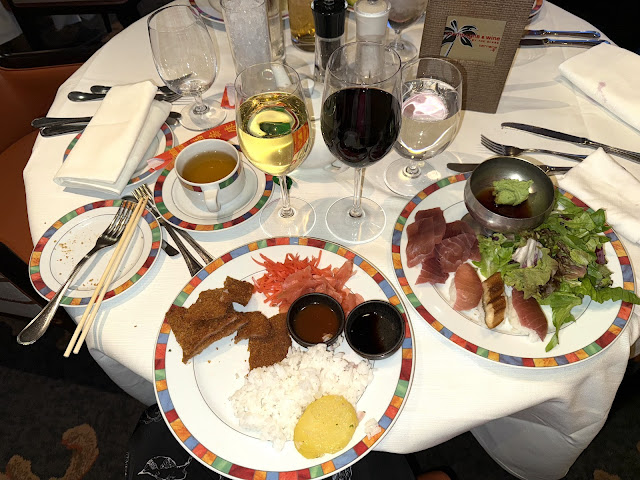We are halfway into our cruise, and this is an unusual day. Yesterday was May 3, and so also is today. We crossed the International Date Line.
I remember once spending a whole day in Tokyo on my birthday. Caught a 6:30PM flight back to Honolulu. Arrived at 7AM. Spent another whole birthday.What is the International Date Line?
- A line between the South and North Poles, passing through the Pacific Ocean, roughly following the 180 degree line of longitude,
- If on the east side, say, Tuesday....on the west side then would be Monday.
- On the opposite side of the globe is the Greenwich meridian.
- The time just west of the international date line is 12 hours ahead of Greenwich mean time.
- The time just east of the IDL is 12 hour behind GMT.
- A traveler going west across the date line adds a day, like us. That is, we are now having our second May 3, back to back.
- This is the difference that made Phileas Fogg win the bet in 1956 Around the World in 80 Days. Interesting film.
- This was Jules Verne's 1872 novel with the same title.
- Introduced the idea of "cameo roles." Also had 68,894 extras from 13 countries.
- Took 75 days to film. The cast and crew did actually go around the world.
- Directed by Michael Todd.
- Was considered to be the single largest movie project ever undertaken at the time.
- Todd married Elizabeth Taylor a year later, in 1957, but died in the plane crash in 1958
- Animated end credits were 6 minutes and 21 seconds long, the longest ever,
- Gregory Peck was originally cast, but was fired for not taking role seriously. David Niven was the replacement.
- Shirley MacLaine was pregnant during filming and suffered from morning sickness whenever she saw green,
- Grossed $42 million (half a billion dollars today) on a $6 million budget.
- For every 15 degrees longitude, we need to move forward our time one hour. We've already done this four times, and have more one-hour adjustments left.
- The 14th century Arab geographer Abulfeda predicted that circumnavigators would lose a day when going west.
- This was confirmed by the Magellan expedition. After sailing westward around the world from Spain, they arrived back on Wednesday, ship's time. But it was already Thursday.
- Began 5000 years ago with sundials, water clocks and other early chronometric tools during time of the ancient Egyptians into the Greeks and Romans.
- The mechanical clock was invented by the 13th century in Europe, spurred by churches.
- In 1807, Eli Terry of Plymouth, Connecticut developed a clock that could be afforded by homeowners.
- In 1883, the U.S. established four time zones. They went ahead and divided the world into 24 time zones. They picked the Royal Observatory as the prime meridian (zero degrees longitude) because two-thirds of the world's shipping already used Greenwich time for navigation.
- Into 1850, Europeans controlled watchmaking.
- However, Aaron Dennison and Edward Howard of the U.S. in 1852 finished 1000 watches, and the American Waltham Watch Company by the mid-1850's sold personal watches. These were worn on the wrist.
- Pocket watches entered during World War I for use on the battlefield.
- Quartz-technology then improved accuracy, to be superseded by the cesium-beam atomic clock by 1950.
But life goes on for our cruise. Played a game with Mint Julep. In honor of the Kentucky Derby.
Dinner and show.
Went up to Horizons for Saturday Night Fever.
Not much walking today.
Today is again May 3, and the lunch was noteworthy. Definitely Japanese, with an unagi bar. First one I've ever experienced.Also roast pork with edible crispy skin.Unagi guy.
Caesar salad bar.
Sushi bar.
Dessert.
Tomorrow we continue at sea. The cruise has so far been reasonably smooth. The cuisine, the best of any other cruise we've experienced. Tonight, our first at Toscana, the Italian restaurant, said to be the most popular of all.-




























Comments
Post a Comment